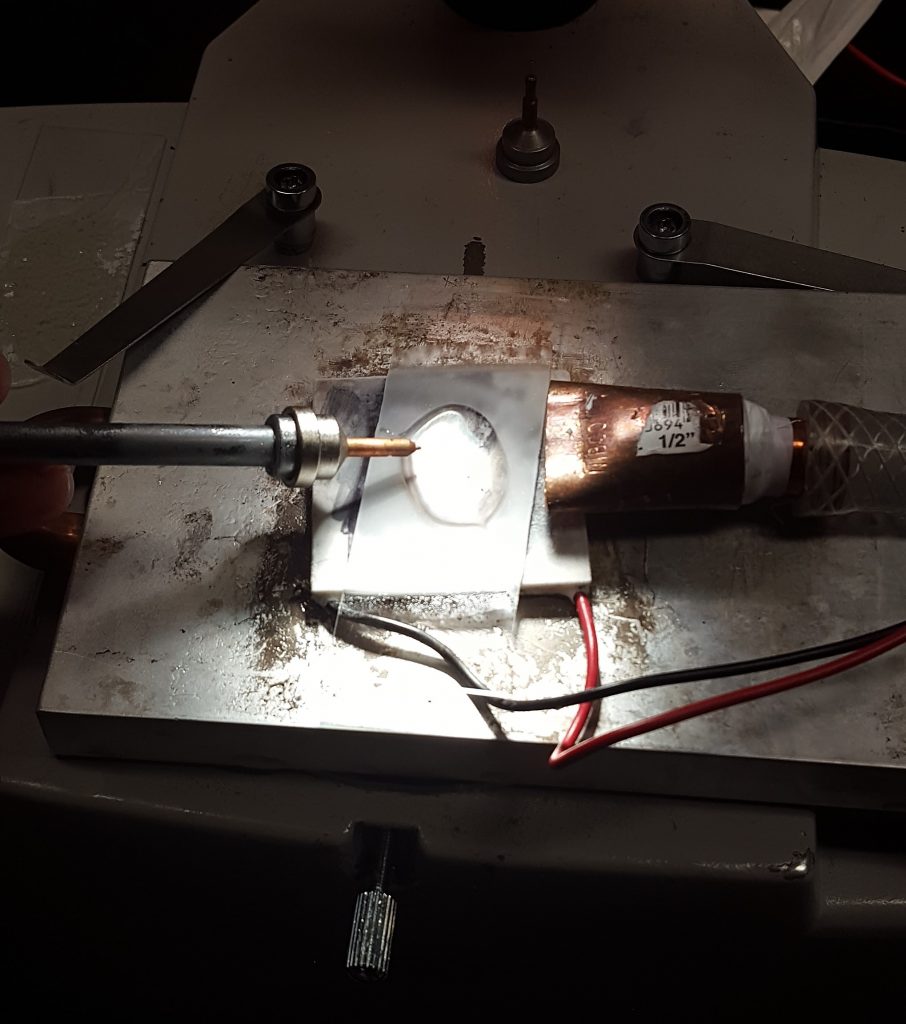For samples that melt below room temperature or lose solvent readily at room temperature where protecting oils are unsatisfactory, you can use the low temperature mounting setup in the X-ray lab. The setup consists of a Peltier chip, a liquid cooled Al block, a power supply for the Peltier chip and a refrigerated recirculating cooling apparatus. The low temperature device is composed of readily available and inexpensive components. A dry source of nitrogen gas is available to minimize ice buildup around the sample. Below are some pictures of the device.

The cooling pump is shown on the right. The power supply for the Peltier chip is to the left of the pump. On the microscope stand is the Peltier chip and Al cooling block. To use the device, turn on the refrigerated recirculating pump. You must turn on both the pump (small box on top) and the chiller. It will take a few minutes to cool the liquid (water and ethylene glycol). Turn on the power supply to the Peltier chip. The on/off switch is located in the back of the grey box. Place a glass slide with some protecting oil on the Peltier chip. Connect the black nitrogen gas line to the flange attached to the Al block and turn on the nitrogen gas. The glass slide and oil will cool in a minute or so. Pipette your sample into the oil and mount your crystal normally.
If the crystal is especially sensitive outside the mother liquor, you may have to immerse your crystal into liquid nitrogen and mount it directly onto the goniometer. This technique takes a little practice but is not especially difficult.
The pump (right) and the Peltier chip power supply. The on/off switch for both the pump and the chiller must be turned on. The on/off switch for the Peltier chip is located at the back of the grey box.

Below is a view of the microscope slide after a few minutes of cooling.

The microscope slide with the protecting oil is shown. A small amount of ice has formed around the Peltier chip. The brass flange is used to direct dry nitrogen gas over the sample to minimize ice buildup. You can adjust the microscope orientation so that you can manipulate your crystals and select a suitable crystal for diffraction. You may have to use the stage clips to hold the Al block in place.
Below is an IR image of the Peltier chip after a few minutes of cooling.

Using a glass slide with a small amount of Paratone-N (STP), the slide temperature is -21.5 ºC. The Paratone-N is quite viscous at this temperature but crystals can be manipulated and separated without difficulty. Crystals that lose solvent readily even in a protecting oil at room temperature can be handled without too much difficulty with this setup. 
For the most sensitive samples, crystals can be dipped directly into a liquid nitrogen bath and transferred onto the goniometer head on the instrument. Use the CryoWand to hold the mounting pin while you secure a crystal. 
Dip the CryoWand into the liquid nitrogen bath. In the bath, secure the mounting pin using the CryoTongs.

You can use the CryoTongs to place the mounting pin and crystal directly onto the goniometer head on the instrument.
If you need to mount several crystals in this fashion, you should warm up the CryoWand and CryoTongs between uses. Frost will form and sometimes cause the mounting pin to freeze to the wand and/or tongs. Run some water over the wand and tongs between use and dry them off with some paper towels.
A hole has been drilled into the Al block for better visualization of the sample. It is difficult to see colorless crystals against the background of the white Peltier chips. The hole can be positioned over the light. Alternatively, the polarizing microscope can be used to view the crystals through the polarizer to get a better idea of the crystal quality before mounting. There will be a loss in cooling as the oil and sample are not directly over the cold Peltier chips.

